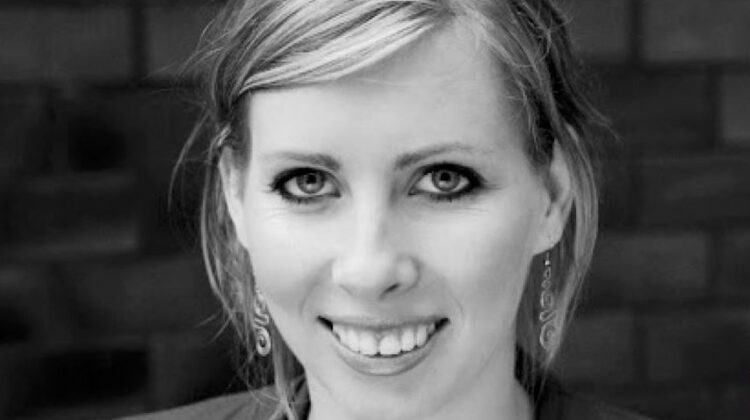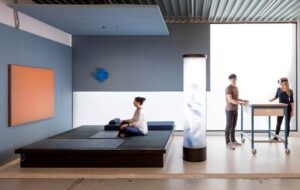
We’d like you to meet the fantastic editors here at Acoustic Bulletin. Most of them have the same job title, ‘Concept Developer’, but what does that mean? And who’s really behind the title? Because even though they share the same title, are very knowledgeable in room acoustics AND super-friendly and helpful, each of them has their own niche that they specialise in, as well as a lot of local knowledge and insight to the domestic market. So we’re starting off by saying hi to Yvette Tietema from the Netherlands.
You’re a ‘Concept Developer – Office’, what does that mean?
It means that I’m constantly working on improving the acoustic comfort for employees in offices in order to keep them productive and healthy. I use my background in facility management and organisational psychology a lot in my current role; I know what pain points facility managers have and where acoustics can add value for them. Also, I have a good network so I can keep up to speed with the latest news in these areas as well.
“I know what pain points facility managers have and where acoustics can add value for them.”
What does that mean in practice?
It can mean many different activities. I support our clients with acoustic surveys and psychologic profiling and I help to create policies and in-house guidelines. But I also do a lot of public speaking, like in-company training courses on acoustics, for example to architects, facility managers and HR people, but also walkthroughs and client visits. Another part of my role that I really enjoy is when I get hired by the Dutch Green Building Council to provide acoustic workshops for the BREEAM-NL experts.
We recently made a psychoacoustic analysis for Enexis, a big company in the Netherlands that is moving to an existing building. The analysis included the physical environment, the work activities, personality profiling and individual factors so we could give the best acoustic strategy for that specific company. We worked together with the end-user, architect and interior architect to give the best acoustic advice from planning until design. That was a really interesting project and the feedback this far has been very positive!
What are you currently working on?
A lot of different things!
The two main ones are a research article with the human-centered expert group of the FMN (Facility Management Netherlands) association on focus work. Where and how can people focus best? Sound is an important aspect to these questions that I want to make sure is included in the discussions and recommendations.

And I just recently presented at Salone del Mobile in Milan at architectural firm D/Dock’s ‘Healing Hub‘ so I’m also doing some follow-ups from that and preparing for an upcoming workshop together with D/Dock and Veldhoen+Company which will be great!
If our readers want to catch up with you, IRL, where can they catch you?
Well, I’ll attend the Smart Workspace Design Summit in Amsterdam, 12-13 October and ERES in Delft, 28/6-1/7 so I’d be happy to catch up with people there!
But I’ll also be busy giving in-house training and workshops on acoustics at different big architectural firms in the Netherlands. Get in touch, if I’m not coming to yours!
Can you describe the local acoustic standard /guidelines in the Netherlands?
We don’t have that many acoustical guidelines. There’s the new revision of Handboek Bouwfysische Kwaliteit Kantoren (Handbook Building Physics Quality in Offices) and then there’s the BREEAM-NL standard. However, the chapter on acoustics is mainly focused on sound insulation and only 3% of the buildings that are BREEAM-NL certified get points on this chapter.
I’m now part of a revision group where we work to get a balance between sound insulation (inside and outside-in), installation sound and room acoustics into BREEAM-NL, so people who use this can create not only sustainable buildings but also comfortable buildings.
What is the indoor room acoustics market like in the Netherlands?
There’s a high awareness of the importance of acoustics.
Most offices are designed according to the activity-based working (ABW) principles and people are realising that in these open structures, there is a need for extra attention to acoustics. My colleagues and I are therefore trying to introduce our activity-based acoustic design concept so that companies will not rely on reverberation time alone but use parameters that fit with the perception of the employees.
What trends in indoor room acoustics can you see in the Netherlands?
We see more recognition that acoustics is an important aspect of the work environment and that focus and privacy has been very underestimated in the past. In general, sustainability is or has to be, the ‘core business’ of every large organisation, so they are also seeking products that are sustainable and circular.
Can you recommend any online resources that our readers may enjoy?
I have a few that I often refer to and recommend to others:
Reading:
- Whitepaper – Towards a productive environment for brainworkers (in Dutch)
- Whitepaper on psychoacoustics by Nigel Oseland and Paige Hodsman
- Brain-Hostile Open Offices: The Fifth BrainChain” by Theo Compernolle. MD., PhD.COMPUBLICATIONS. 2014. www.brainchains.org
Videos:
- How old are your ears? Test which high tones you can still hear.
- How and when sounds activate our brains and why it is important to limit sound propagation is explained in the documentary “The Secret Life of Buildings”. Here you can see how an EEG cap is used to show how our brains respond to stimuli such as sound.
- The effect of the AC value on sound propagation.
- An interesting TedTalk on the effect of sound on people by Julian Treasure.
Do you have any advice for acousticians on how to work and collaborate with architects, facility managers or others involved in the building process?
Make it simple.
End-users don’t get all the formulas and what it is for. We have to speak their language and make it practical in order to solve their problems.
Follow Yvette on Twitter Follow @yvettetietema or connect with her on LinkedIn .
Read an interview with Holger Brokmann, Concept Developer Education in Germany.

